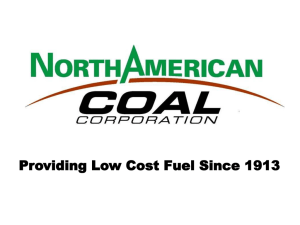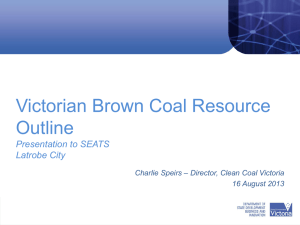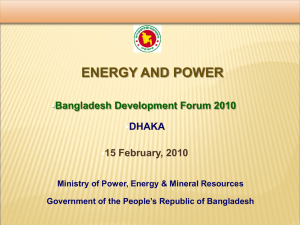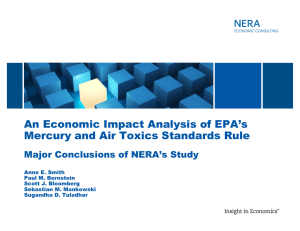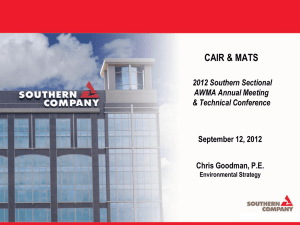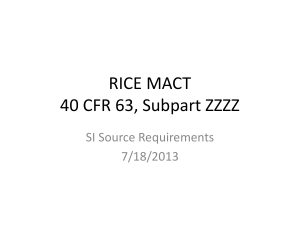Bob Bibbo, Vice President, Normandeau Associate
advertisement
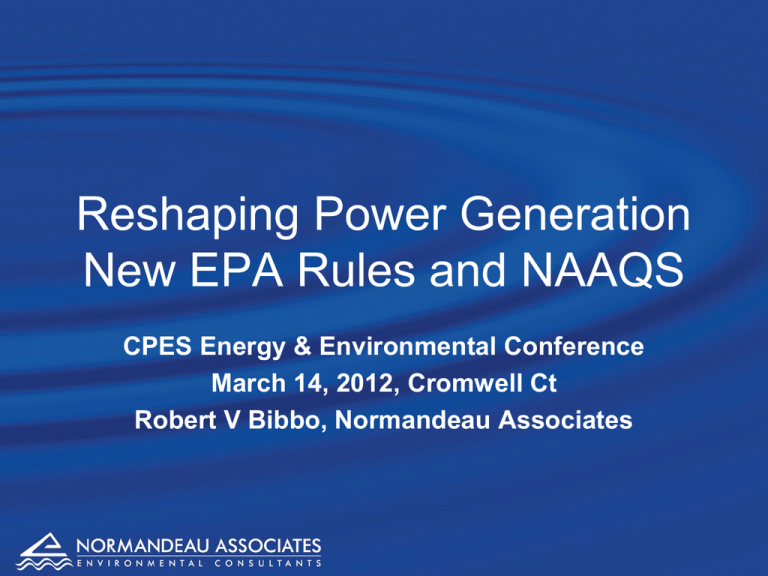
Reshaping Power Generation New EPA Rules and NAAQS CPES Energy & Environmental Conference March 14, 2012, Cromwell Ct Robert V Bibbo, Normandeau Associates The Leading Contenders Carbon free Wind and Clean Natural Gas Wind Turbines Combined Cycle NGas New National Ambient Air Quality Standards and EPA Rules Impacting EGUs CAA • Nitrogen Dioxide (NO2) 100 ppb, NAAQS • Sulfur Dioxide (SO2) 75 ppb, NAAQS • Pressure PM2.5 and Ozone NAAQS more stringent • Rules for GHG emissions (Tailoring Rule &NSPS) • Mercury Air Toxics Rule (MATS) or Utility MACT • Cross State Air Pollution Rule (CSAPR V1) CWA • 316(b) Rule for Cooing Water Intake Structures • Effluent Guidelines for Waste Water Discharges RCRA • Coal Combustion Residual (CCR) Rule New SO2 and NO2 NAAQS Create a Nonattainment Hazard 1. Attainment (region is attaining a NAQQS SO2, PM2,5 NOX) - PSD-NSR permitting rules apply - BACT (best available technology with a consideration of cost) - Compliance with NAQQS, Increments and AQ values 2. Nonattainment --NA (region is not attaining a NAAQS) - NA-NSR permitting rules apply - LAER (lowest achievable emission rate technology with no consideration of cost) - Purchase of emission offsets at ratios greater than unity - Demonstrate progress toward attaining the NAQQS3. 3. NA Pollutants of concern---S02, NO2 (on&off balance sheet) 4. AQ modeling can create hidden (off balance sheet) NA liabilities. Rules for GHG (CO2) Emissions Tailoring Rule and NSPS Final Tailoring Rule: Compliance for all Units July 2011 • Major Source 100,000 TPY (new and existing) • Modification is Major if 75,000 TPY or greater 10 mw of coal 20 mw of NG • New Major or Major Modification PSD Permit –Best Available Control Technology (BACT) improved efficiency, fuel switch, sequester CO2 NSPS: Final Rule Expected May 2012 • Best system of emission reduction • Establishes starting point for BACT • Allows EPA to establish performance guidelines for existing sources for states to address in SIP process. Mercury (Hg) Air Toxics Standard (MATS) Formerly Utility MACT Final Rule 12/2011 (hazardous pollutants or air toxics) • Coal and oil-fired power plants are covered by this rule • All hazardous air pollutants must have standards • Standard at least as stringent as the emission reductions achieved by the average of the top 12% best controlled sources in a source category • New Plants must match the best performing source in category • Compliance is 3 years with a 4th from state agency discretion is possible. A 5th from EPA through AO if reliability is in jeopardy (should be very difficult) • Revises NSPS for new coal and oil-fired power plants MACT Standards for coal and oil-fired EGUs 1. Mercury (Hg) Hg limit (coal), part of metal air toxics limit (oil) 2. Acid Gases limits (HCL, HCL and HF) 3. Metal air toxics limit (filterable particulate) 4. Toxics Organics through work practice standards rather than numerical limits 4. Remedies to meet limits (cleaner coal, FF, ESP, activated carbon, lime duct injection, repowering to NGas CCGT). For oil, use ultra low distillate, switch to NGas , add on controls? 5. Major Concern --New MACT and Tailoring Rule limits will discourage new coal plants. Cross State Air Pollution Rule CSAPR •CSAPR V1 (2012, 2014) System of annual and seasonal allowances • V1--1997 Ozone NAAQS and PM2.5 NAAQS. Reduce S02 by 73% and NOx by 54%. Based on a system of annual and seasonal allocations. •CSPAR V2 &V3 likely for 2008 Bush Ozone Std and 2013 std, revision of annual PM2.5 std. •Application of FGD (SOx) and SCR for NOx, cleaner coal, conversion to NGas • Cross State Air Pollution Rule (CSAPR) Version 1 (V1) July 2011. Rule stayed on 12/30/2011 316(b) Rule Under Clean Water Act Cooling Water Intake Structures (CWIS) Draft rule in comment Phase Final rule expected July 2012 • Minimize adverse impacts on adult fish, juvenile fish (impingement), small juveniles, fish larvae, fish eggs and larvae(entrainment) through location and design of CWIS • Affects 670 EGUs mostly (B10, ACC and SEC) • Performance standards for Impingement - flows > 2MGD - use of Ristroph screen and fish return to limit fish mortality>>>>>>>>>>>>>> 316(b) continued • Performance Standards for Entrainment - actual flow of 125MGD - no best technology available (BTA) declared - case by case determination - cost and benefits can be considered • The solution is cooling towers Cooling Tower Options Stricter Effluent Standards for PP (CWA) Coal Combustion Residuals (CCR) Rule (RCRA) 1. Effluent Standards Under Development - NOPR 07/12 Final Rule Post 2015 - Toxic metals in waste waters from coal activities, FGD, cooling towers, and chemical use is the motivator - apply treatment technologies to meet stricter limits 2. Coal Combustion Residuals Rule (final post 2015) - option 1: treat as a special -hazardous waste subject under requirements of sub title C of RCRA - option 2: treat as a non-hazardous waste sub D of RCRA EPA sets performance standards states responsible for enforcement Engineering specs for liners, GW monitoring and SS similar Projected Retirements UBS # units 2011 (57) 2012 (55) 2013 (54) 2014 (57) 2015 (59) 2016 (54) 2017 (51) 2018/20 (57) (56) 31 21 16 39 22 9 9 11 158 MWs 3366 2775 2536 8543 3777 1875 1469 1645 26918 SNL # units 2011 (53) 29 2012 (55) 25 2013 (51) 18 2014 (54) 49 2015 (58) 29 2016 (56) 12 2017 (59) 7 2018/20 (55) 12 (55) 181 MWs 3151 2973 2536 8543 3739 1875 1038 2577 26432 Brayton Point Power Plant 1530MW (1095 Coal, 437 NG/O) 1.1 Billion in Environmental Controls $713 /kw (800-1000 /kw new NGCC, 400 kw for used ) Natural Draft Cooling Towers Air Pollution Controls for SOX, NOX, Hg and GHG Homer City Generating Station (PA) 1900 MW Coal $700 million Upgrade for MATS and CSAPR $368/kw New England Retirements 32,000MW Fleet (30% coal and oil) NERC ISONE ISONE Hart Bus.com CTDEEP General Buzz 4000 MW at risk 3300 - 5300 MW at risk 1000 MW due to MATS/MACT 9000MW replacements by 2021 Factoring Retirements into 2012 IRP Integration of Ngas and wind replaces retired oil and coal





